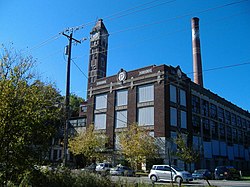Peters Cartridge Company
|
Peters Cartridge Company
|
|

Peters Cartridge Company
|
|
| Location | 1415 Grandin Rd., Kings Mills, Ohio |
|---|---|
| Coordinates | 39°21′1″N 84°14′33″W / 39.35028°N 84.24250°WCoordinates: 39°21′1″N 84°14′33″W / 39.35028°N 84.24250°W |
| Area | 14.2 acres (5.7 ha) |
| Built | 1916 |
| Architect | Schilling VanLeyer & Keough |
| Architectural style | Prairie Style |
| NRHP Reference # | 85003115 |
| Added to NRHP | October 10, 1985 |
The Peters Cartridge Company was a company in Kings Mills, Ohio that specialized in gunpowder and ammunition production. Its historic buildings, built in 1916 at 1915 Grandin Road, were added to the National Register of Historic Places on October 10, 1985.
Joseph Warren King purchased the Austin & Carleton powder mill on the Little Miami River in 1855 and expanded it as the Miami Powder Company including the company town of Goes Station, Ohio. King sold the Miami Powder Company in 1877 to build the Great Western Powder Works with the company town of Kings Mills at a more favorable hydropower location downstream of Goes Station. A wooden dam diverted water into a power canal through the gorge in a narrow valley between steep adjacent hills. Manufacturing facilities were dispersed along the 2-mile (3.2 km) power canal to minimize damage during infrequent explosions. King's son-in-law Gershom Moore Peters began working at the powder mill in 1881 and became president of the powder company when King died in 1885. Peters formed the Peters Cartridge Company at Kings Mills in 1887. Machinery was manufacturing four-thousand cartridges per hour by 1889.
A collision of loaded railway cars being shunted at the powder works on 15 July 1890 triggered an explosion killing twelve people and starting fires destroying the railroad station, the freight house, two Peters Cartridge Company office buildings, the shell factory, the cartridge loading plant, a large warehouse and six employee residences. Wood-frame structures were rebuilt on the opposite side of the river from the old powder works included a large shot tower completed in 1895. The last wood-frame structures were machine shop building R-3 and shotgun shell loading building R-21 built in 1907. With the approach of World War I the company received large ammunition orders from the Russian Empire and from the United Kingdom of Great Britain and Ireland. Bullet manufacturing building R-6 was built of brick; and money from wartime contracts was used to replace most of the old wooden framed buildings with brick and reinforced concrete structures including the main R-1 building in 1916, the R-17 power house in 1917, metallic cartridge loading building R-2 in 1918, primer assembly building R-9, and the R-23 indoor shooting range and ballistics laboratory in 1919. A taller brick shot tower painted with a large P became a local landmark.
...
Wikipedia


